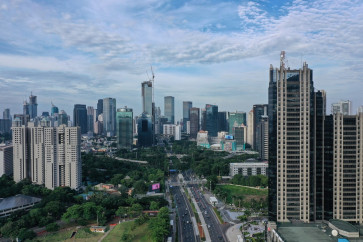Popular Reads
Top Results
Can't find what you're looking for?
View all search resultsPopular Reads
Top Results
Can't find what you're looking for?
View all search resultsNew Year bustle in Jakarta’s Chinatown
Chinese New Year lanterns hang outside a shop on Jl
Change text size
Gift Premium Articles
to Anyone
Chinese New Year lanterns hang outside a shop on Jl. Kemenangan Tiga in Glodok, West Jakarta.
The zigzagging alleyways, festively colored by ornaments in shades of bright red with generous dashes of gold, were crowded with people making their last purchases ahead of the Chinese New Year.
West Jakarta’s hot and humid weather is intensified in the narrow alleys, but it did not stop people from flocking to the capital’s Chinatown in Glodok in the last week of January, ahead of the Chinese New Year, which falls on Feb. 10.
Throughout January, Glodok was busy as ever, save for the week when it was submerged in chest-deep floodwater. Chinatown — or pecinan to the locals — is located just to the south of Jakarta’s Old Town.
The area’s main roads – Jl. Pancoran, Jl. Kemenangan and Jl. Perniagaan – were filled with decorative lanterns, banners, lamps, angpau envelopes and children’s clothing for sale, all glowing in red.
Seventy-year-old calligrapher Akwet works in his small studio on Jl. Pancoran VI, Glodok, West Jakarta.
The holiday’s signature food dodol Cina — the Chinese toffee-like sweet and sticky cake made from glutinous rice flour and caramel sugar — was on sale at nearly every street vendor in the area.
Workers were also seen renovating a number of temples in the area, dusting off their compounds, adding another coat of paint and preparing bundles of incense sticks.
For 70-year-old Akwet, the weeks ahead of Chinese New Year, locally known as Imlek, were full of joy and expectation, despite the culmination of the rainy season and the floods that it brought.
“I have received many orders for banners, decorations, you name it,” Akwet told The Jakarta Post at his small shop on Jl. Pancoran VI in Glodok.
Akwet is a Chinese calligrapher. “The oldest and the last of my trade in this area,” he proclaimed with an old, ink-filled brush in hand.
Two women light incense sticks before prayers are performed at the Jie De Yuan or Dharma Bakti Temple in Glodok.The agile and vigorous man stopped his work as he recalled the days of the strong repression of Chinese culture in Indonesia.
“If it wasn’t for Gus Dur, Chinese calligraphy and my business would barely exist,” Akwet said referring to the country’s fourth president.
During the Soeharto era, all Chinese culture was effectively banned for more than 30 years, as the government did not openly recognize the Chinese language or any celebration of the Chinese New Year.
It took until the year 2000 for then president Abdurrahman “Gus Dur” Wahid to remove the ban against Chinese culture and language, allowing Chinese religions and traditions to be practiced freely.
Then, in 2003, Gus Dur’s successor, Megawati Soekarnoputri, declared Chinese New Year a national holiday for all to enjoy.
Worshippers conduct religious observances at the Dharma Bakti Temple.
Akwet said that since that time, Chinese celebrations and his business had steadily grown.
In his book Historical Sites of Jakarta, historian Adolf Heuken S.J. said that long before Portuguese ships sailed the waters of Southeast Asia, Chinese junks had frequented Java Island harbors and many Chinese had already settled on the island’s north coast.
Around the turn of the 17th century, when the Dutch began establishing Batavia — as Jakarta was called then — at the mouth of the Ciliwung River, there was already a Chinese village there.
Other historical records showed that the Dutch later decided to evict the Chinese, which resulted in the infamous massacre of Chinese in 1740. The Chinese were later told to settle in the area now known as Glodok.
Praptini, 45, a worker at the 500-year-old Vihara Dharma Jaya temple, locally known as Toa Se Bio, also recalled that 2003 was the year Chinese New Year celebrations were most vibrant.
“I think it has weaned since then, especially in the last few years,” she said.
Praptini could not pinpoint the exact cause, but suspected the economy was to blame. “I don’t know, but I think it has been a hard time these past few years,” she said.
Traditional sticky rice cakes dodol Cina, a treat to mark the Chinese New Year, are ready for sale on Jl. Kemenangan Tiga.
Where to visit
• Toa Se Bio and Jin De Yuan temples
The main entrance to the Dharma Bakti TempleThere are five temples around Chinatown, but Jin De Yuan and Toa Se Bio are the two most visited by tourists. Jin De Yuan or Dharma Bakti is located on Jl. Kemenangan III and was built in 1650. Toa Se Bio or Dharma Jaya is located on the same street and was originally built in 1714 and restored in 1751.
• SMA 19 High School
The building used for the high school
used to be Tiong Hoa Hwe Koan, the first modern Chinese school in
Batavia, which was established in 1900. It was later taken over by the
Dutch colonial government. It is located on Jl. Perniagaan.
• St. Maria de Fatima Catholic Church
The church, also located
on Jl. Kemenangan III, was originally the house of a Chinese trader and
was once also used as a temple before being turned into a church in
1954.
What to taste
• Bihun Kari Lam
Bihun kari lam.Located on the corner of Jl. Pintu Besar Selatan 3, a small alley more famously known as Gang Gloria is a small food court. One of the favorite meals is a comfort dish of thin noodle rice served in a thick beef curry.
• Kopi Es Takkie
Takkie coffee shop’s iced coffee and nasi campur.This coffee shop is located on Gang Gloria, which is also the center of culinary delicacies in Glodok. The coffee shop is a traditional Chinese coffee shop with wooden tables and chairs. The coffee is served in a tall glass. Iced coffee is a favorite.
• Lontong Capgomeh
Just outside the coffee shop, there is a famous lontong capgomeh vendor. This is a dish of rice cake served with either chicken or vegetable curry, a fusion of Chinese and local cuisines. People of Chinese descent in Indonesia prefer to have it as their main meal for Cap Go Meh, the 15th day of the New Year, hence the name.
— Photos by Andreas D. Arditya

















